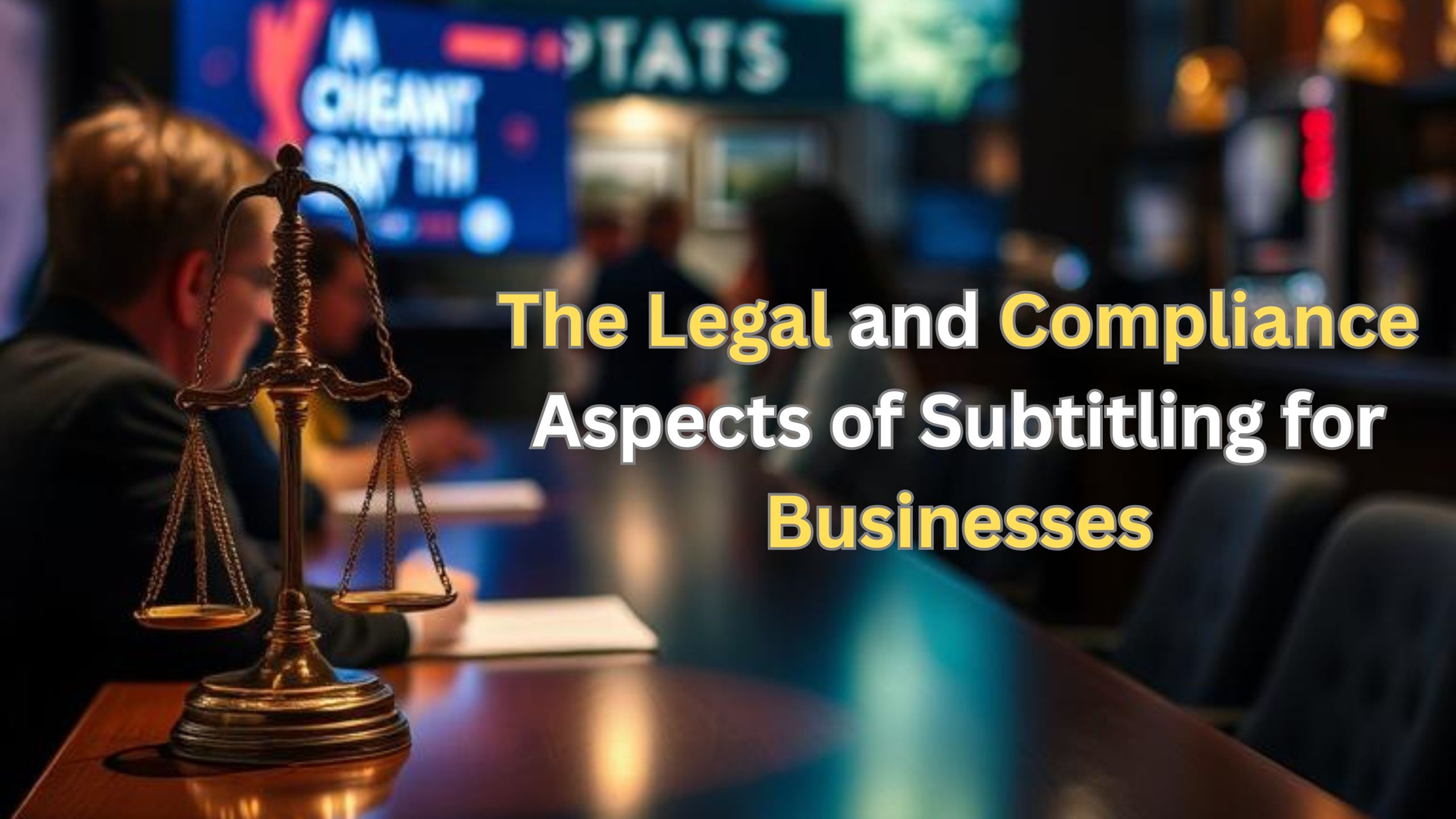Blogs
The Legal and Compliance Aspects of Subtitling for Businesses

Introduction
In today’s multimedia-driven business landscape, subtitles are not just an accessibility feature—they’re a legal and compliance necessity. With increasing pressure from governments, regulators, and consumers to make content inclusive, businesses must now ensure that their video communications, whether internal or external, comply with accessibility laws and meet industry standards.

For companies distributing videos online or via broadcast, subtitling plays a crucial role in achieving regulatory compliance, promoting inclusivity, and avoiding costly legal pitfalls. As the world becomes more digitally connected, understanding the legal obligations of subtitling is critical—not just for media companies, but for all industries.
Why Legal Compliance in Subtitling Matters
Businesses increasingly rely on video for marketing, training, e-learning, product demos, customer support, and corporate communication. In many regions, video content must be accessible to a diverse audience—including those with hearing impairments, language barriers, or learning disabilities.
Failure to comply with subtitling requirements may result in:
- Legal penalties
- Lawsuits under accessibility legislation
- Reputational damage
- Loss of market access (especially in regulated markets like the US, EU, and Canada)
Key Laws Governing Subtitling and Accessibility
To understand the compliance landscape, businesses need to be aware of regional laws that govern video accessibility and captioning:
1. The Americans with Disabilities Act (ADA) – United States
The ADA mandates that public-facing communications must be accessible to individuals with disabilities. Courts have ruled that this includes online video content, meaning businesses must provide captions or subtitles for training videos, advertisements, tutorials, and more.
2. Section 508 of the Rehabilitation Act
This U.S. law applies to federal agencies and their contractors. The law requires organizations to make all electronic and information technology—including videos—accessible to people with disabilities, often through closed captioning or subtitling.
3. The Communications and Video Accessibility Act (CVAA)
This law impacts broadcasters and digital platforms, requiring that video content distributed online include subtitles or closed captions, particularly if it previously aired on television.
4. European Accessibility Act (EAA) – European Union
The EAA will enforce accessibility requirements across EU member states. It mandates that online services, including audiovisual media, be inclusive for people with disabilities—which includes mandatory subtitling and captioning.
5. Accessibility for Ontarians with Disabilities Act (AODA) – Canada
Under AODA, businesses operating in Ontario must ensure that their video content is accessible, with subtitles or closed captions provided for the deaf and hard of hearing.
Open vs. Closed Subtitles: What’s Legally Required?
Closed Subtitles (Closed Captions):
Viewers can turn these on or off, and they often include sound effects, speaker identification, and non-speech elements. Most legal requirements, including ADA and CVAA, specifically refer to closed captioning for compliance.
Open Subtitles:
Viewers always see these, as they are permanently visible and cannot be disabled. While they improve accessibility, they are not always sufficient to meet legal standards, especially if they omit non-verbal audio cues.
For full compliance, businesses should prioritize closed captioning with complete audio descriptions.
Industry-Specific Subtitling Requirements
Healthcare
Medical institutions and pharmaceutical companies must subtitle patient education videos, training modules, and regulatory content to comply with HIPAA, FDA, and state laws related to accessibility.
E-Learning and Education
Schools and corporations offering online learning platforms must ensure that lectures, tutorials, and assessments have subtitles to comply with Title II of ADA, Section 504, and WCAG (Web Content Accessibility Guidelines).
Banking and Finance
Financial institutions must make promotional and instructional videos accessible as part of their consumer protection responsibilities, especially under equal opportunity regulations.
Penalties for Non-Compliance
Not complying with subtitling and captioning laws can have serious consequences:
- Legal action under federal or civil rights laws
- Heavy fines
- Bans on content distribution in specific markets
- Loss of contracts, especially with government or public agencies
- Public backlash and negative press
Lawsuits against major companies like Netflix, Harvard, and Amazon have already set precedents—highlighting that ignorance of the law is not a valid defence.
How Businesses Can Ensure Compliance
To remain compliant and avoid penalties, businesses should follow these best practices:
1. Partner with Professional Subtitling Services
Using AI-generated subtitles without human review can result in errors that may lead to legal trouble. Businesses should work with trusted subtitling providers who are familiar with industry regulations and quality standards.
2. Implement Accessibility from the Start
Instead of retrofitting subtitles post-production, build accessibility into your workflow. This ensures legal compliance and reduces editing costs.
3. Adhere to WCAG 2.1 Guidelines
The Web Content Accessibility Guidelines (WCAG) provide global best practices for subtitle accessibility, including:
- Subtitle clarity and accuracy
- Contrast ratios for readability
- Synchronization with audio
4. Provide Multilingual Subtitles When Needed
If your business operates internationally, regional authorities may require you to provide subtitles in the local language to meet compliance laws and licensing standards.
Passive Voice in Compliance Documents
In legal subtitling, professionals frequently use passive voice to maintain objectivity and neutrality, especially in corporate, instructional, or legal video content. For example:
- “The policy was reviewed and updated.”
- “Access was granted to all participants.”
This tone supports legal defensibility and is often preferred in regulatory environments.
FAQs – The Legal and Compliance Aspects of Subtitling for Businesses
Not always, but most public-facing and internal training videos must be accessible in regions covered by ADA, AODA, or EAA. If your audience includes employees, clients, or the public, subtitles may be required to comply with local accessibility laws.
Inaccurate subtitles can misrepresent your message, alienate viewers, or even violate compliance standards—especially if required by law. Lawsuits and brand damage can follow, particularly in healthcare, education, and government sectors.
Automated tools may help speed up the process, but human editing is critical to ensure accuracy. Legal compliance requires a high degree of precision, especially in regulated industries. Hybrid models that combine AI and human review are recommended.
Conclusion – The Legal and Compliance Aspects of Subtitling for Businesses
The legal landscape around subtitling is evolving rapidly, and businesses can no longer treat subtitles as an afterthought. Regulatory compliance, accessibility standards, and inclusion mandates make subtitling a business-critical function.
By understanding the regional laws, investing in quality subtitle creation, and staying up to date with accessibility regulations, businesses can avoid penalties, expand their reach, and enhance brand reputation.
“Compliance isn’t just about avoiding fines—it’s about creating content that’s truly inclusive.”
